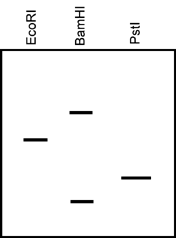
The following problems are to help you sharpen and deepen your understanding of recombinant DNA methods and applications. These questions will be discussed in the recitation section on Nov. 7. Problems are not to be handed in and will not be graded.
1. A linear DNA fragment is cleaved with one, two or three restriction enzymes to yield fragments as follows:
| Enzyme(s) | Fragments (kb) |
|---|---|
| HindIII | 2.5, 5.0 |
| SmaI | 2.0, 5.5 |
| HindIII + SmaI | 2.5, 3.0, 2.0 |
| HindIII + SmaI + EcoRI | 1.5, 2.0, 2.5 |
Draw the restriction map of the original DNA fragment, indicating the positions of all restriction sites.
2. [From Griffiths et al., Introduction to Genetic Analysis] A cystic fibrosis mutation in a certain pedigree involves a change in a single base-pair. This change destroys an EcoRI restriction site normally found in this position.
b) Suppose you detect that a woman in this family is a carrier. She is married to an unrelated man who is also a heterozygote for cystic fibrosis, but in his case it is a different mutation in the same gene. How would you counsel this couple about the risks of a child having cystic fibrosis?
3. You wish to clone the gene for polyhydroxychickenwire hydroxylase from the Mexican axolotl. Fortunately, you have already cloned the gene for this enzyme from the Uruguyan wild llama. You digest axolotl DNA with restriction enzymes, separate the DNA fragments by gel electrophoresis, make a Southern blot, probe the blot with labeled DNA from the complete llama clone and make an autoradiogram. You see the following:

Explain how you would go about cloning the axolotl gene, including the following:
Return to Honors Genetics Main Page